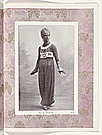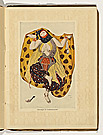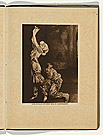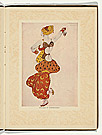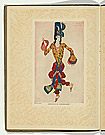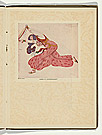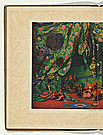Shéhérazade
Choreographic drama in one act
- Producer: Les Ballets Russes de Serge Diaghilev
- Premiere: 14 June 1910, Théâtre national de l’Opéra, Paris
- Costume design: Léon Bakst
- Costumier: Marie Muelle
- Scenery design: Léon Bakst
- Music: Nikolai Rimsky-Korsakov
- Choreography: Michel Fokine
- Libretto: Léon Bakst and Michel Fokine, after the first tale of
A thousand and one nights - Main characters: Zoebéide (Zoebeida), Zoebéide’s Favourite Slave, Shah Shahriar, King of the Indes, Shah Zeman, the Chief Eunuch, Odalisques, Almées (dancing girls)
The ballet is set in the harem of the Oriental palace of the Persian ruler, Shah Shahriar. Suspecting his wives of infidelity, the Shah and his brother, Shah Zeman, leave the palace on the pretence of a hunting expedition. As soon as the men leave, the women, lead by Shahriar’s favourite wife Zoebéide, persuade the Chief Eunuch to release their slave lovers. Shahriar and his brother return unexpectedly and burst in on the ensuing orgy. Enraged at his discovery, Shahriar orders his guards to kill the women and their lovers. Zoebéide pleads for mercy, but finding her husband unrelenting, she stabs herself in the heart and falls dead at his feet.
Schéhérazade created a sensation in the Ballets Russes’ 1910 season, its design by Bakst building on the powerful visual effects of his earlier Cléopâtre. This dance drama was the first production completely devised by Diaghilev and his miriskusniki collaborators, bringing together vivid visual spectacle, powerful choreography and a re-orchestrated version of the 1888 symphonic suite that Rimsky-Korsakov had based on tales from The arabian nights. Bakst’s costumes are an imagined orientalist amalgam of Ottoman and Persian styles, pale and diaphanous silk harem pants for the almées contrasting with strongly coloured, embroidered and intricately structured silk and velvet costumes for the lead male characters. Bakst’s drawing for Shah Zeman is an earlier, more ornate, version of the Shah’s actual costume, accentuating the strong rhythms of the dancer’s body by depicting the fabrics and the skirt ornaments as moving and floating. With gold body paint and bejewelled outfit, Nijinsky commanded the stage with his voluptuous and feline performance as Zoebéide’s favourite slave. Against the set’s emerald green walls and red carpets, the massed costumes of dancers in frenzied motion created a moving spectacle of colour intensifying towards the ballet’s orgiastic and violent climax.





